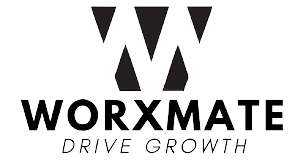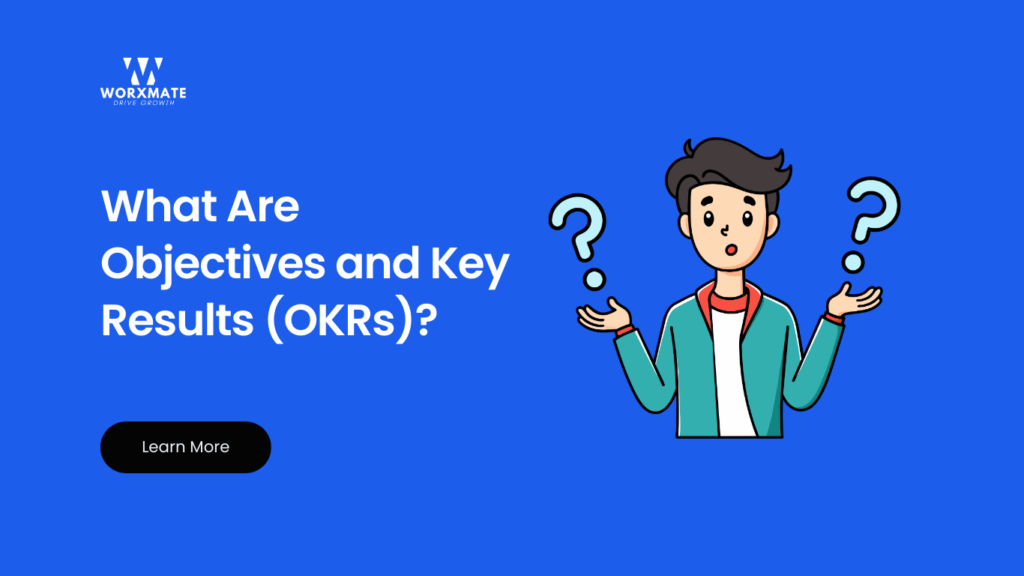Summary:
OKR (Objectives and Key Results) is a goal-setting framework that helps organizations define clear, measurable objectives and track progress through specific key results. Originating at Intel and popularized by companies like Google, OKRs drive alignment, focus, and accountability across teams. This blog explains what OKRs are, their history, types, benefits, and how to write and implement them effectively. It also includes a case study on Google’s success with OKRs and highlights how Worxmate’s OKR & Performance Management System can simplify goal tracking and boost organizational performance.
In today’s fast-paced business environment, organizations need effective frameworks to set ambitious goals and track progress.
Enter OKRs (Objectives and Key Results), a powerful goal-setting methodology that has transformed how leading companies align their teams and drive performance.
This framework, adopted by tech giants like Google and countless other successful organizations, provides a clear structure for defining what you want to achieve and how you’ll measure success.
Whether you’re looking to improve team alignment, boost productivity, or drive innovation, understanding OKRs can be a game-changer for your organization.
Understanding the Objectives and Key Results OKR Framework
OKR stands for Objectives and Key Results, a collaborative goal-setting methodology used by teams and individuals to set challenging, ambitious goals with measurable outcomes. This framework consists of two primary components that work together to create focus and drive results.
What Are Objectives?
Objectives are clear, action-oriented statements that define what you want to achieve. They should be:
- Clear and understandable
- Challenging yet achievable
- Aligned with organizational goals
- Inspiring and motivational
Objectives answer the question: “What do we want to accomplish?” They guide teams by providing direction and focus.
What Are Key Results?
Key Results are specific, measurable outcomes that track progress toward an objective. Effective key results are:
- Specific and time-bound
- Measurable and verifiable
- Aggressive yet realistic
- Quantifiable (often on a 0-100% scale or with numbers)
Key results answer: “How will we know we’re making progress?” At the end of each period (usually a quarter), key results are graded as achieved or not, with no ambiguity.
-
OKR Formula:
The basic formula for every OKR follows this simple structure: “I will [Objective] as measured by [Key Results]”.
The History of the OKR Framework
The development of OKRs is generally attributed to Andrew Grove, who introduced the approach to Intel in the 1970s.
Grove documented the framework in his 1983 book “High Output Management,” laying the foundation for what would become a revolutionary approach to goal setting.
In 1975, John Doerr, then a salesperson working for Intel, attended a course taught by Grove where he was introduced to the theory of OKRs (then called “iMBOs” or “Intel Management by Objectives“).
Later, when Doerr was working for venture capital firm Kleiner Perkins in 1999, he introduced the idea of OKRs to Google.
The concept took hold rapidly at Google, becoming central to their culture as a “management methodology that helps to ensure that the company focuses efforts on the same important issues throughout the organization”.
Since then, OKRs have been adopted by numerous organizations worldwide, from startups to Fortune 500 companies.
Benefits of Using OKRs
Implementing OKRs in your organization can deliver numerous advantages that drive performance and growth:
-
Team Alignment
OKRs connect team and individual goals to the company’s strategic mission. Top managers set company-wide OKRs (preferably in collaboration with the entire team), departments then set their OKRs to help achieve company objectives, and individuals set personal OKRs aligned with team goals. This ensures everyone is moving in the same direction.
-
Flexibility
Unlike traditional long-term strategic planning, OKRs focus on short-term goal cycles (typically quarterly), while still supporting alignment with long-term objectives. This approach allows teams to adjust and adapt to change, reducing risks and waste. The ability to balance short-term execution with long-term vision makes OKRs particularly valuable in fast-changing industries.
-
Focus
OKRs help teams focus on what truly matters. With a recommended 2-4 Objectives for each team/individual and no more than 3-5 Key Results per Objective, OKRs eliminate distractions and keep everyone concentrated on priority initiatives.
-
Autonomy and Accountability
The bottom-up goal-setting approach enables companies to leverage frontline expertise to make improvements. Since top management typically knows only about 4% of frontline problems, this methodology helps melt the “iceberg of ignorance”.
-
Engaged Employees
Clear objectives and measurable results keep employees engaged and motivated. When team members understand how their work contributes to organizational success, they’re more likely to remain committed and productive.
Read More: Benefits of OKR Software for Startups
Types of OKRs: Aspirational vs. Committed
Understanding the different types of OKRs is crucial for implementing them effectively:
-
Committed OKRs
Committed OKRs, also known as “roof shot goals,” are demanding yet achievable goals that teams must complete within a given cycle.
In this type of OKR, all Key Results must reach 100% completion within a set timeframe. They provide clear roadmaps for what should be prioritized and are designed to drive performance and tangible results.
-
Aspirational OKRs
Aspirational OKRs, also called “moonshots,” “stretched,” or “10x goals,” are big, ambitious goals that a company or team sets for itself.
They focus on the company’s vision and are intentionally designed to be very challenging, such that the team is not expected to fully achieve them within an OKR cycle. Instead, they inspire teams to think creatively and aim high.
-
Choosing the Right Balance
The nature and strategy of your organization determine which type of OKR is most appropriate:
-
- Companies focused on innovation and willing to embrace risk might favor aspirational OKRs
- Risk-averse organizations or those in critical phases (like financial difficulties) may prioritize committed OKRs
- Most organizations benefit from a blend of both types, adjusted according to current strategic priorities
How to Write Effective OKRs
Creating powerful OKRs involves a systematic approach:
-
Step 1: Identify Priorities Before Writing OKRs
Reserve OKRs for a few top priorities – they should not encompass everything you need to do. Start by identifying the few things that would make the biggest difference in the next cycle (typically 90 days). Ask questions like:
-
- What are the most important things we need to get done this cycle?
- If we got any one of them done, what would be better?
- What needs to change from where we are today?
If your list exceeds five items, try to narrow your focus to three or fewer.
-
Step 2: Write Your Objective
Convert your priorities into Objectives that are significant, concrete, action-oriented, and inspirational. A good Objective communicates what you want to accomplish in a short, memorable statement.
-
Step 3: Write Your Key Results
For each Objective, define 3-5 Key Results that will measure your success. Ensure they are specific, measurable, and verifiable.
Implementing OKRs in Your Organization
Successful OKR implementation requires careful planning and execution:
- Start with education: Ensure everyone understands the OKR methodology
- Begin with leadership: Have executives set company-level OKRs first
- Cascade thoughtfully: Allow teams to create their OKRs aligned with company objectives
- Keep it simple: Start with a small number of OKRs and expand gradually
- Review regularly: Schedule weekly check-ins and quarterly reviews
- Iterate and improve: Learn from each cycle and refine your approach
Case Study: OKR Success Stories Across Industries
The OKR framework has driven transformative outcomes across diverse sectors, from technology giants to financial institutions. These case studies demonstrate how organizations leverage OKRs to align strategy, accelerate innovation, and achieve measurable results.
-
Google: Scaling Ambition Through OKRs
Google’s adoption of OKRs in 1999, when the company had just 40 employees, became a cornerstone of its hypergrowth. A pivotal example was the objective to “Improve YouTube’s mobile experience”, with key results focusing on reducing video load times by 50% and increasing mobile watch time by 30%.
By aligning engineering, design, and marketing teams around these metrics, YouTube achieved a 40% reduction in buffering and a 25% rise in mobile engagement within two quarters. As Larry Page noted, “OKRs kept us focused on outcomes rather than outputs, which was critical as we scaled”.
-
Intel: Strategic Pivot via Measurable Goals
Intel’s shift from memory chips to microprocessors in the 1980s exemplifies OKRs’ role in executing high-stakes pivots. Under Andy Grove’s leadership, the company set an objective to “Dominate the microprocessor market”, with key results including capturing 80% of the PC CPU market and reducing production costs by 20% annually.
These OKRs enabled Intel to reallocate R&D resources decisively, culminating in the Pentium processor’s launch, which achieved a 90% market share within three years. Grove’s mantra-“Only the paranoid survive”-was operationalized through OKRs that fostered relentless execution.
-
Global Financial Institution: Cost Optimization via Cross-Functional Alignment
A McKinsey case study highlights a financial institution that reduced customer service costs by 50% using OKRs. The objective “Streamline customer-service efficiency” was supported by key results like automating 70% of manual processes and cutting average handling time from 15 to 7 minutes.
Cross-functional “squads” (product, tech, risk) aligned under a single metric: cost-per-service interaction. Quarterly reviews revealed that teams using OKRs resolved dependencies 40% faster than traditional departments, achieving the target in 18 months.
-
Quick Heal Technologies: Cultural Transformation Through Agile OKRs
Indian cybersecurity firm Quick Heal faced resistance when transitioning from a rigid annual review system to OKRs. The CHRO, Reetu Raina, set an objective to “Build a performance-driven culture”, with key results including 100% OKR adoption across teams and a 30% improvement in goal transparency.
Despite initial pushback-only 40% of employees engaged initially-leadership hosted biweekly “OKR clinics” to address concerns. Within a year, 85% of employees reported clearer priorities, and high-performer retention rose by 25%.
-
Agile Banking: Deloitte’s OKR-Driven Product Launches
A Deloitte-led agile transformation at a North American bank used OKRs to accelerate product releases. The objective “Deliver customer-centric digital banking solutions” included key results like reducing feature deployment cycles from six months to two weeks and achieving 90% automated test coverage.
Teams adopted quarterly OKRs with “program increments” (PIs) to adjust funding based on metrics such as customer acquisition rates. This approach cut time-to-market by 60% and increased mobile app adoption by 200,000 users in one fiscal year.
These cases underscore OKRs’ versatility in driving outcomes-whether enabling moonshot innovations at Google or streamlining operations in traditional sectors. By linking ambitious objectives to quantifiable results, organizations foster alignment, accountability, and agility in an increasingly volatile business landscape.
A Quick OKR Example:
Objective:
Enhance Product Differentiation to Gain Market Share
Key Results:
KR-1: Identify and Implement Three Unique Product Features
KR-2: Launch Two Major Product Updates Focused on Differentiation
KR-3: Improve Customer Satisfaction Score by 20%
KR-4: Reduce Churn Rate by 15%
Objectives set the vision, while key results provide the measurable steps to get there, when combined, OKRs transform lofty goals into actionable plans.
OKR Examples Across Teams
| Team | Objective | Key Results |
|---|---|---|
| Marketing | Increase brand awareness | Gain 5,000 new social followers; 3 PR features; 2 webinars |
| Sales | Boost quarterly revenue | Close $1M in new deals; 20% upsell to existing clients |
| Product | Enhance product reliability | Reduce bugs by 50%; Achieve 99.9% uptime |
| HR | Improve employee engagement | Raise engagement score from 70% to 85%; 95% survey participation |
Wrapping Up
Objectives set the vision, while Key Results provide the measurable steps to get there. When combined, OKRs transform lofty goals into actionable plans.
The origin of OKRs teaches us that with the right goals and clear steps to achieve them, anything is possible — from Intel’s labs to Google’s boardroom, and now to your team.
As you embark on your OKR journey, remember the words of Peter Drucker:
“What gets measured, gets managed.”
With Objectives and Key results you’re not just setting goals; you’re crafting the roadmap to success. Embrace the clarity and direction they provide and watch your team achieve remarkable success.
Ready to transform your organization with effective OKRs? Try Worxmate today and discover how our OKR Software can help your teams align, focus, and achieve exceptional results.
Schedule a OKR demo with Worxmate now and witness the magic tomorrow!



